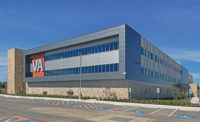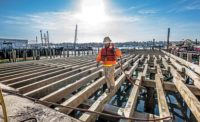Elizabeth River Tunnels Project
Portsmouth & Norfolk, Va.
Best Project, Highway/Bridge; Best Project, Excellence in Safety
Owner: Virginia Dept. of Transportation
Lead Design Firm/Civil Engineer: WSP USA Inc.
General Contractor: SKW Constructors (a Skanska USA, Kiewit Construction, Weeks Marine Inc. JV)
Developer/Concessionaire: Elizabeth River Crossings OpCo
Construction Quality Control Lead Consultant: HNTB Corp.
Subcontractors: Conley Environmental Corp.; Waterfront Marine Construction Inc.; Norfolk Dredging Co.; Seaward Marine Corp.
Despite using a tunnel design rarely used in the U.S., a joint venture of Skanska, Kiewit Construction and Weeks Marine safely delivered the $2.1-billion Elizabeth River Tunnels project in September, one year ahead of schedule. The new, nearly 3,800-ft-long tunnel under the Elizabeth River between Portsmouth and Norfolk, Va., is one of the first U.S. all-concrete, immersed-tube tunnels designed for deep water.
The project was developed under a public-private partnership between the Virginia Dept. of Transportation and Elizabeth River Crossings, the Macquarie-Skanska consortium that financed the project and will operate and maintain the tunnels and other facilities for a 58-year concession period. The construction joint venture, dubbed SKW Constructors, held the design-build contract for site and bridge work and constructing a new tunnel as well as rehabilitating three existing tunnels and constructing an expressway extension. Virginia DOT maintains ownership of the infrastructure and will continue to oversee the developer’s activities and operation.
“For such a huge project, I thought the innovation was impressive,” one Best Projects judge says.
Wade Watson—SKW Constructors’ project director—credits the job’s success to the strong partnership among all parties. “We had a real relationship, not just partnering,” says Watson, who was named one of ENR’s Top 25 Newsmakers last year for his work on the project. “We were open and honest with each other. We discussed issues. We were very up front. In that kind of relationship, where each party trusts the other and you build some trust, you can discuss anything you want and find good solutions. That was important in this kind of job because there are always issues.”
The new tunnel includes 11 reinforced-concrete segments, each 16,000 tons, that were fabricated at a deepwater facility near Baltimore. By using concrete immersed-tube elements, the team reduced the amount of steel used compared with more conventional steel tubes used throughout the U.S. Dozens of concrete-mix iterations yielded a recipe that satisfied durability mandates for a 120-year design life and that had a high resistance to cracking, the team says.
Tunnel element buoyancy was critical because each element—roughly 350 ft long, 55 ft wide and 28.5 ft high—needed to float high enough to be towed down the Chesapeake Bay from the casting site to the project site. Casting the elements required precise calculations and tracking the weight of materials to achieve design-weight tolerances and to ensure the correct level of flotation. The new tunnel also marked the first use of concrete bulkheads on a deepwater tunnel, according to the team.
The tunnel elements were precisely designed to receive enough ballast for their ultimate immersion in the river. When positioned above their final position on the riverbed, water was added to the ballast tanks to sink the elements into position.
Watson says the immersion process required highly detailed planning. “Immersion appeared as a couple of lines in our big schedule,” he says, “but that was broken down to a minute-by-minute process for 40 hours.”
Ian Chaney, deputy project manager with WSP USA Inc.—the project’s lead designer—says the immersion process required extra levels of teamwork. “If [immersion] was more than ¼-inch off and the alignment wasn’t what we expected, we’d work through the roadway and make sure it fit,” he says. “The structural engineers looked at the gaps to assure that everything would be successful from the standpoint of leaks and durability. Instead of lifting the element back up and placing it again, we had on-the-fly approvals of tunnel element placement.”
The project’s complexity stemmed in part from the design and construction of multiple, simultaneous project components, including two buildings, five pump stations, 10 bridges and flood-control elements and rehabilitating three existing tunnels. Extensive environmental permitting was also required.
Watson says that the project was originally planned as a six-year contract with “zero flex schedule” with a May 2018 completion date. Once the project got underway, however, the team refined its planning to reduce the schedule and “squeeze activities.” In the end, the tunnel phase of the project was completed six months ahead of schedule, with the tunnel opening in June 2016.
The tunnel rehabilitation work was originally scheduled to take 18 months, after the new tunnel was finished. The team, however, developed ways to rehabilitate sections of the existing tunnels while they remained open to traffic. That strategy enabled the project to cut an additional six months from the schedule. The final rehabilitated tunnel was completed in May 2017, a year early.
Due to the project’s unusual nature, virtually no field personnel had any experience with the immersion technique. SKW Constructors instituted extensive training for workers and provided crews with detailed work plans.
Those efforts also aimed to improve safety. Workers completed a total of more than 50,000 hours of in-classroom safety training, including Injury-Free Environment training, which focuses on workers’ personal relationships to safety. Construction work plans were completed before each work activity to identify hazards and controls related to the task.
Workers logged 5 million hours on the job and the project achieved a 1.92 Occupational Safety and Health Administration recordable incident rate. Watson says that in the project’s early stages, the team’s incident rate was higher than that, but through continuous improvement of the safety training process, it was able to reduce incidents significantly. Total claims were one-eighth of the projected amount, Watson says. “The severity of claims was very low,” he adds.
One Best Projects safety judge says, “The commitment to safety is paramount through the implementation of an injury-free environment. Involvement from the entire company, regardless of tenure or position, and the philosophy of intolerance of injury or incident, is a model for others to strive to achieve.”
The project has already eased traffic congestion, saving the average commuter between 30 and 60 minutes per day, round-trip.
Related Article: Region’s Best Work Meets Big Challenges






Post a comment to this article
Report Abusive Comment